When it comes to comparing knife blade shapes, it’s all about when, where, and how you plan on using it. Two of the most popular blade shapes on the market today are Tanto and Drop Point. This article will take you through the pros and cons of both, as well as, a brief history of both the Tanto and Drop Point.
If you are looking to show off an impressive knife that really packs a punch, the Tanto shape may be for you. The clean lines and nice point definitely make it a crowd pleaser. The Drop Point, on the other hand, is an all around effective blade shape that will aid you in nearly any cutting task. This is why the Drop Point is a preferred EDC blade shape.
Tanto blades are actually more than just pretty. They do have a purpose. This blade is designed specifically for punching through armor. The Tanto has been used in close combat for centuries. In a survival situation where you may need to puncture through hard materials or forcefully dig and scrape, it’ll be your best friend. The strong chisel tip design will stand up to numerous brutal blows, where other blade shapes may snap or fail to puncture. It most certainly has its place in the bug out bag and is a the go-to in the tactical community. You won’t, however, be mincing wild onions for omelets on the next family camping trip with this knife. The straight edge and lack of belly just won’t support the rocking motion needed for this type of quick slicing. Really that’s what it’s all about, knowing when to use what to be most effective.
Drop Point blades are all around good at most any cutting needs. It is the preferred blade shape for hunting and EDC. The thicker spine of the blade makes a slow steady curve toward the tip, actually placing the tip closer to the midline of the knife’s entirety. This gives easy and precise control of the tip, when needed. If you’re having to dig a splinter(or worse) out of your skin, you would much rather do it with the maneuverability of a Drop Point. The long sloping cutting edge that spans the length of the blade also reduces cutting time, as you are able to make longer strokes. As a hunting knife, this is a desirable trait making quick work of skinning animals, while the precision tip makes it less likely that you would nick any internal organs in the cleaning process. The curved belly also provides a nice rocking motion for cutting herbs, vegetables, and fruits. The Drop Point is ideal for daily living tasks.
As you can see, each of these blades are extremely useful and can make life a lot easier, depending on what you are doing at the time. Read on for the Pros and Cons of both revealed.
Tanto Pros and Cons
Pros
Tip Strength
Designed to Puncture/ Stab
Excellent Combat Weapon
Pleasing to the Eye
Easy to Sharpen in the Field
Cons
Not Good for Slicing
Need to Sharpen Both Edges
Not Good for Precision Cutting
Drop Point Pros and Cons
Pros
Belly Shape is Good for Slicing
Easy to Control Tip for Precision Cutting
Good for Nearly Any Cutting Task
Good Survival Blade Choice
Cons
Not Designed to Puncture/ Stab
Tanto Blade History
The Tanto blade design has been around for centuries, dating back to feudal Japan era when the Heian family ruled. There was an uprising that brought about the need for personal protection, as well as, the need for an elite class of soldiers to protect the ruling family. This elite class of soldiers is what we commonly refer to as the Samurai, and could be seen with the menacing Tanto at their sides. The production of Tantos, or “short swords,” ebbed and flowed with the presence of violence in Japan. During times of peace, production came to a near halt only to pick up again during war times. Though primarily used as a weapon, the Tanto also had its place in ceremony within Japanese culture. Ritual suicides were performed with this blade. Ceremonial Tanto were more ornate and boasted intricate detailing of the handle and many keep older ones as collector pieces
America’s fascination with martial arts in the late 1970’s, gave way to the rise in popularity of the Tanto blade in the United States. Cold Steel manufactured the first American made Tanto blades for knives in the early 80’s. This shape and look soon became a staple in the tactical world and remains very popular to this day. It is no wonder that it has remained so, with it’s sleek look, Samarai history, and dominating puncture power. Personal defense in close combat backed by centuries of use, makes the Tanto a natural choice in weapon. Pictured below is an example of a Tanto tactical knife commonly found on today’s market.
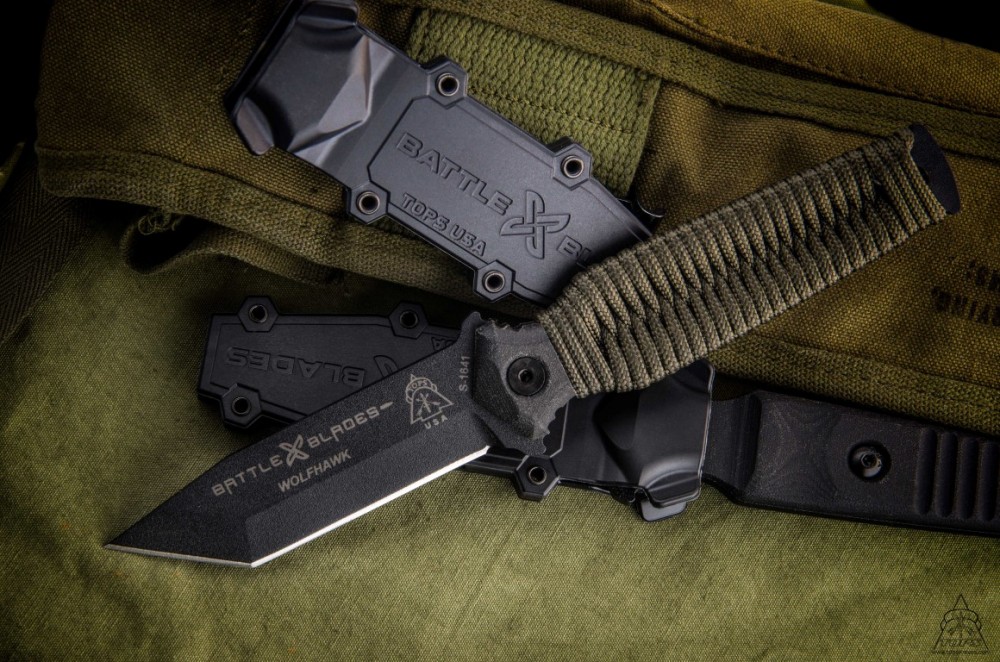
Drop Point Blade History
The Drop Point blade is probably the most common blade shape. It is recognizable by its sloping spine that curves inward, dropping the point closer to midline of the knife. The center alignment of the tip is key in making this style easy to control and good for detailed work. There is speculation over where this design actually originated. The origins of blade design are sometimes hard to trace, as these tools of necessity have been around for a very long time. That and the fact that function and intended use can only bring about so many variations in style make it very difficult to nail down some of the more basic designs.
Some give this style’s credit to R.W. “Bob” Loveless and the Drop Point Hunter he designed in the 1950’s. The Drop Point Hunter (pictured below) was extremely popular among knife enthusiasts, hunters, and outdoorsmen. There are a number of articles online featuring information about this particular knife, with avid hunters touting its praises. Apparently, it created quite a frenzy upon release and lasted for years to come. If he didn’t actually invent it, he definitely had hand in making it popular. It was simple and designed to be highly functional, which is why so many have modeled their design from this shape. It is most likely that the design came about out of sheer necessity, answering the need for versatility and function. This makes the Drop Point the obvious blade shape to cover a wide variety of utilitarian uses. It is definitely a must if you like to consider yourself “prepared” for whatever may come your way. The Drop Point can be found in a number of folding pocket knives, as well as, fixed blades.
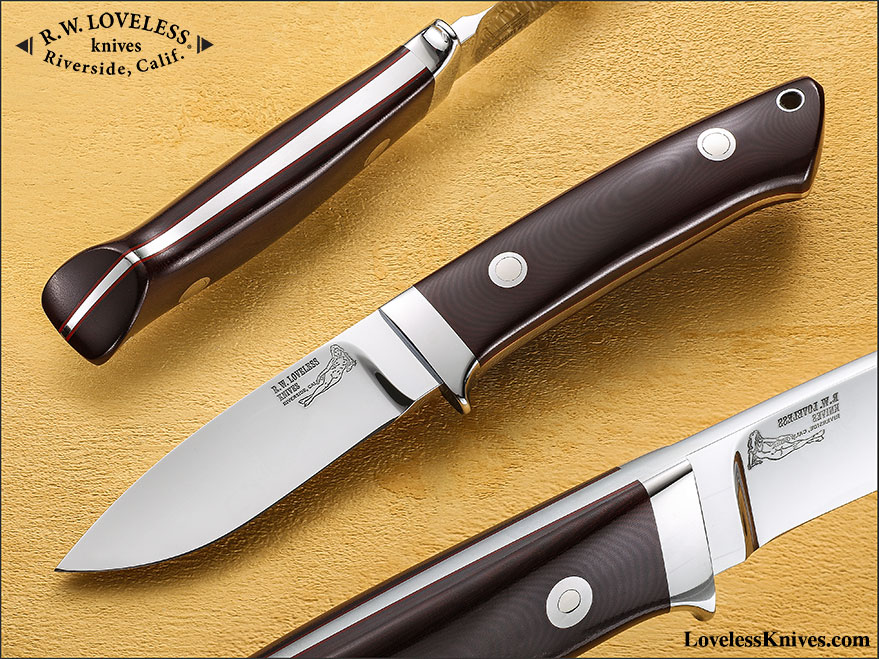
Conclusion
Among the many blade types available on today’s market, both the Tanto and the Drop Point are highly regarded in the realm of Survivalists and Tacticians. Each of these knives would make an awesome addition to your supply. There are a number of other things to consider when deciding on what knife is best for your needs: steel composition, fixed or folding, etc. As for blade shape, you should have a pretty good idea of which of these blades are suitable to your purpose. It’s even likely that you may have decided that you need both a Tanto and a Drop Point, but for different reasons.
Knowledge is your absolute greatest asset, when it comes to survival. You can have all the gadgets in the world and still be rendered helpless, if you don’t know when or how to use them. In today’s world, we have access to more tools and weapons than ever before… We also have access to more information than ever before. Now, you are armed with the knowledge that in reality the Tanto will serve you best as a personal protection weapon, while the Drop Point is a very handy tool for every day tasks.
Other Popular Blade Shapes
The following infographic was pulled from Knafs.com and shows each of the different blade shapes in detail. As you can see, there are plenty to choose from. Just remember that each of these blade shapes are designed for a specific purpose and make sure it suits your needs. Some are very versatile and address several different needs, while some really only serve one purpose. In the following paragraphs, you will find information and pros/cons of the most popular blade shapes for knives today.

Sheepsfoot Blade
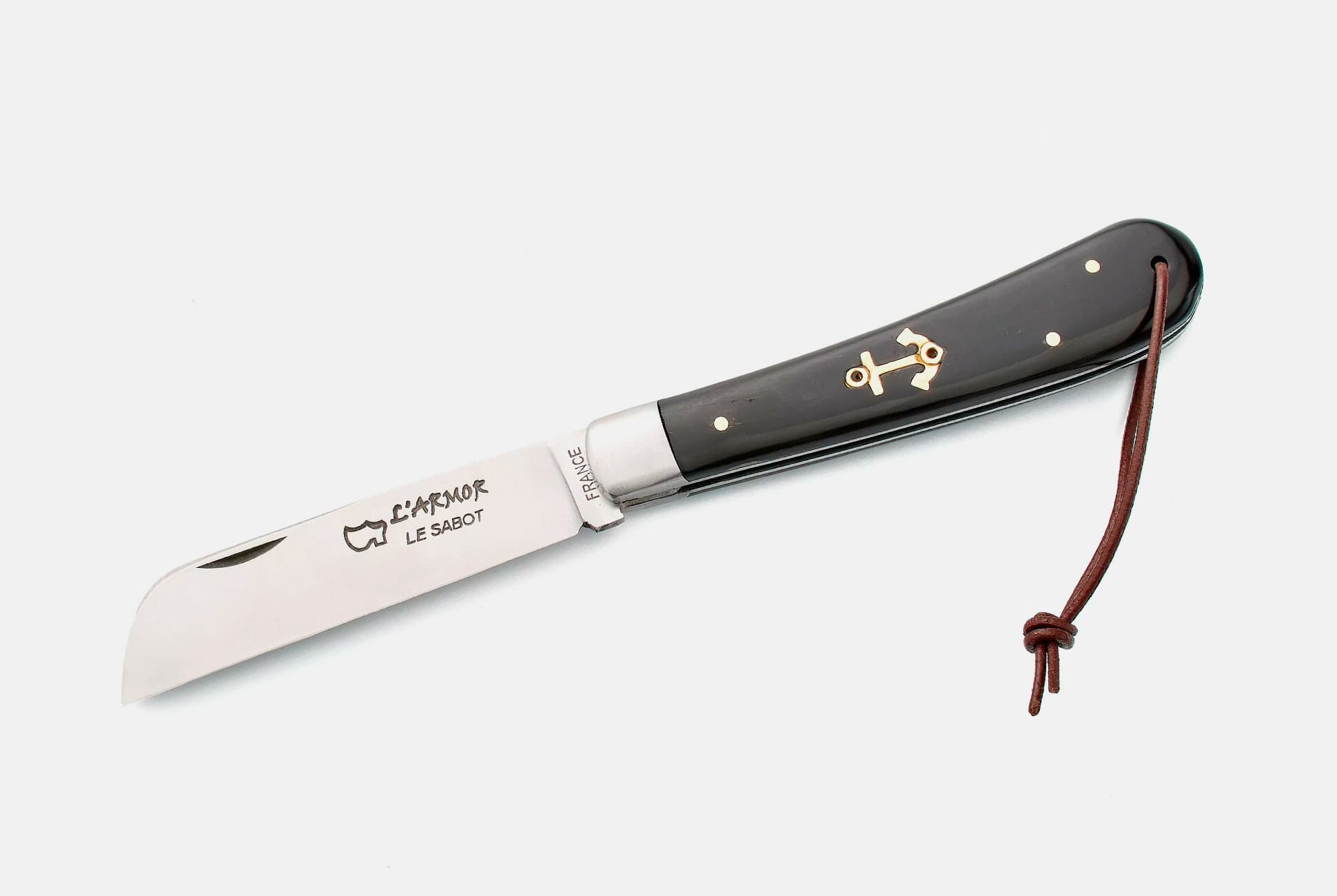
The Sheepsfoot Blade is characterized by its large straight belly cutting edge and false point. The spine(dull edge) of the blade travels most of the length parallel to the cutting edge. Then, it slopes in, drastically at the end, not providing much of a point at th tip. It was designed for trimming sheep hooves without an accidental puncture. This actually makes it perfect for EMT’s, Firemen, and other rescue personnel that may need to cut someone free of straps or fabric. Here, we see a blade designed with a single purpose in mind that over time came to serve elsewhere.
Sheepsfoot Pros
Great for Carving
Safe Against Accidental Puncture
Strength Distributed the Length of Cutting Edge
Excellent Rescue Tool
Sheepsfoot Cons
Not Good for Slicing(using rocking motion)
Not Good for Puncturing
Clip Point Blade
The Clip Point Blade is easily recognizable as it looks like the top(unsharpened) edge has been clipped at an angle to bring the point midline. So, this knife shape is much like the Drop Point, in where the actual point falls midline providing increased control and precision. It just appears to be clipped, instead of having that slow curving gradual drop. This blade shape, seen on Bowie Knives and movies like Rambo, is very versatile. Much like the Drop Point, it is useful for a number of tasks. This make it a popular choice for survival/ tactical purposes.
Clip Point Pros
Belly Shape is Good for Slicing
Sharp Tip Allows for Puncturing
Easy to Control Tip for Precision Cutting
Good for Nearly Any Cutting Task
Good Survival Blade Choice
Clip Point Cons
Weak Tip Does Not Allow for Forceful Puncturing of Hard Surfaces
Wharncliffe Blade

The Wharncliffe Blade is much like the Sheepsfoot, with its long straight cutting edge. The spine(dull edge) of the blade is where it differs, with it making a wide gradual slope downward to meet the cutting edge. This blade shape is named for the first Lord of Wharncliffe in Britain, after his suggestion for a stronger cutlery blade. However, evidence shows that this design had already been around for quite some time, as can be seen in the Viking Seax below. Nonetheless, the Wharncliffe is a popular choice among knife enthusiasts today.

Wharncliffe Pros
Great for Carving
Safe Against Accidental Puncture
Strength Distributed the Length of Cutting Edge
Wharncliffe Cons
Not Good for Slicing(using rocking motion)
Not Good for Puncturing
Spear Point Blade
The Spear Point blade is symmetrical in shape, with both edges tapering in to a midline tip. It is aesthetically pleasing to the eye, being evenly proportioned and well balanced. These knives can be found with both edges sharpened or just one. Often seen in throwing knives, this shape has excellent piercing capabilities. This is also why it ranks high in terms of a self defense blade. You may also hear Spear Point knives referred to as daggers.
Spear Point Pros
Strong Point Shape
Excellent Piercing Capability
Easy to Control Midline Tip
Spear Point Cons
Not as Easy to Sharpen
Small Cutting Edge
Hawksbill Blade

The Hawksbill Blade is easily recognizable as both the cutting edge and the spine curve inward, resembling the beak of a hawk(hence its name). It is not a common blade shape and is limited in capabilities. However, it can be very useful for repeated tasks like cutting cord or stripping wire. One drawback to this shape is how difficult it is to sharpen. Lately, this blade shape has gained popularity for tactical purposes due to its high performance in combat situations.
Hawksbill Pros
Sharp Tip
Excellent Combat Weapon
Design is Perfect for Certain Tasks
Hawksbill Cons
Nearly Impossible to Sharpen
Limited to Certain Tasks
Straight Back Blade

The Straight Back(or Normal) blade shape is what you see in a typical kitchen knife. It has a straight spine, with the cutting edge sloping upward to meet it. It is an excellent blade for chopping and mincing vegetables, as you can push down on the flat edge applying pressure with each slice. The rocking motion that makes quick work of cooking tasks is performed with ease, using the Straight Back blade.
Straight Back Pros
Excellent for Slicing
Performs Pulling Cuts Well
Straight Back Cons
Tend to be Heavier
Trailing Point Blade
The Trailing Point blade is evident when the spine of the blade, as well as, the bottom edge both slope slightly upward at the tip. Both edges are sharpened, making it an excellent fillet knife. It is popular among hunters and fishermen. While it is useful in this aspect, being doubled edged prevents one from applying downward pressure with their hand.
Trailing Point Pros
Efficient at Piercing
Good for Skinning/ Slicing
Versatile Double Edge
Trailing Point Cons
Can Only Apply Force Using Handle
Pen Blade
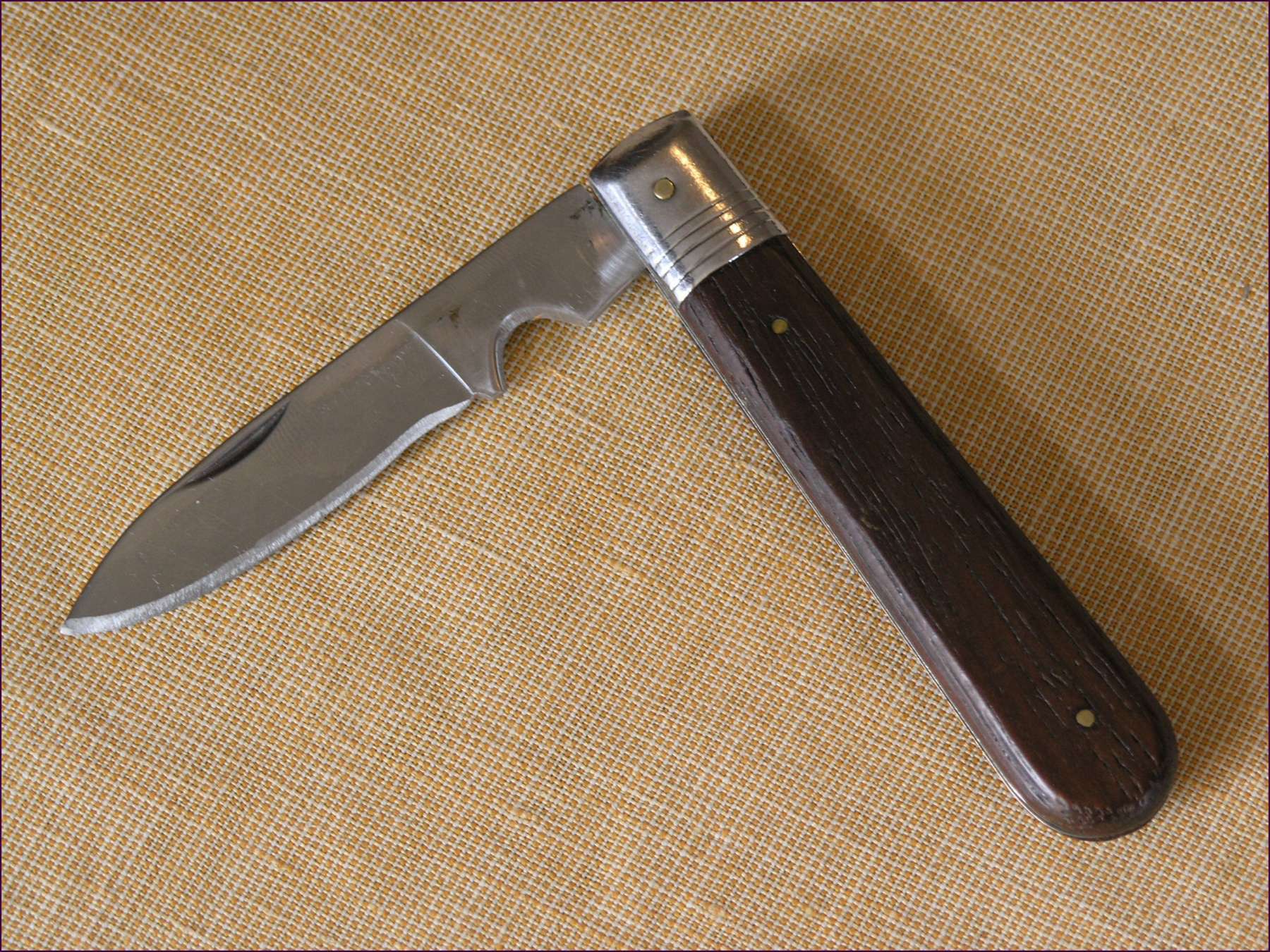
The Pen blade is common in pocket knives and can be seen in the popular Swiss Army Knife. It is characterized by a center spine and symmetrical curve on each outer edge, sloping inward at the end to leave the tip centered. Closely resembling the Spear Point design, only the Pen blade has one sharp edge.
Pen Pros
Dull Edge Allows to Apply Pressure
Versatile and Compact
Point is Midline for Easy Control
Easy to Sharpen
Pen Cons
Not Good for Chopping
Not Good for Piercing
Needle Point Blade

The Needle Point blade is just what it sounds like… With two sharp edges tapering quickly into a sharp point, this blade shape is designed for piercing. The blade is usually thin and won’t hold up to strong materials, but it will definitely pierce soft materials with the ease and precision of a needle. Game of Thrones fans know that this was the blade Jon Snow gifted to Arya Stark in Season 1. As he handed it to his little sister he says, “Stick them with the pointy end.” She even named it Needle and it sufficed at checking some of the enemies off the “list” she recited every night before bed. He gave her this as weapon of self defense, since he would be leaving Winterfell headed for The Wall. Neither of them knew, in that moment just how handy that Needle would be. These little daggers don’t seem very intimidating, but considering what their purpose is, I would most certainly steer clear of the pointy end.
Needle Point Pros
Sharp Tip for Puncturing
Double Edged for Versatility
Needle Point Cons
Weak Design May Break
OUR RECOMMENDED TACTICAL GEAR LIST:
- Best Health and Fitness Tracker, Whoop. Get 1 Month Free: See it here!
- EDC Assisted Opening knife we can’t live without: See it here!
- Best EDC Concealed Carry Pistol: See it here!
- Extreme Performance Morning Dink: See it here!
- Best 3D Printer For Gun Parts and Accessories: See it here!
- Our Top Rated EDC Flashlight: See it here!
- AR Red Dot Sight We Can’t Live Without: See it here!
- Best Handgun Safe For Quick Access: See it here!
- Top Wireless Security Camera For Home Security: See it here!
- The Range Bag You’ve Always Been Looking For: See it here!
- CIA Approved Sharp Shooting Course: See it here!

